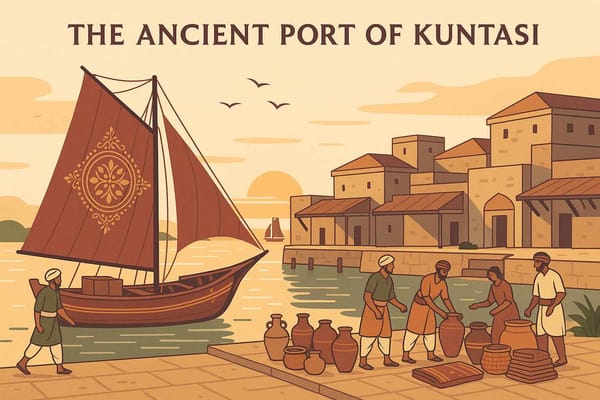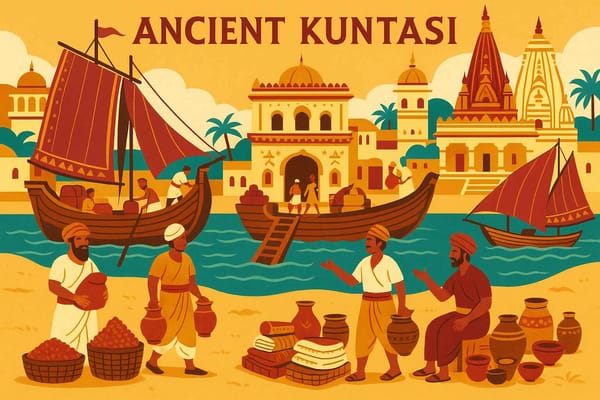
Ancient Port of Kuntasi- Gateway to the Past: History and Exploration
Imagine standing on the banks of a quiet river in Gujarat, the wind carrying whispers from thousands of years ago. This isn't just any land; you're at Kuntasi, a place that was once a bustling port, a vibrant artery of the great Indus Valley Civilization. It feels almost unreal to think that from this very spot, around 2200 BCE, ships laden with treasures sailed towards the Persian Gulf, connecting our ancestors with distant lands like Mesopotamia. Kuntasi is not just a collection of ruins; it's a story of our glorious past, a forgotten chapter of India's maritime legacy waiting to be heard.
Uncovering the Secrets of Kuntasi: A Gateway to the Ancient World
For a long time, Kuntasi was just a mound of earth, its stories buried under layers of time. It was first noted by the explorer P.P. Pandya and later brought to life through the dedicated excavations by Y.M. Chitalwala. What they found was truly remarkable—a well-planned settlement that thrived in two distinct phases: the Mature Harappan period (around 2200–1900 BCE) and the Late Harappan period (around 1900–1700 BCE).
So, why was this place so special? Kuntasi’s strategic location on the Phulki River, just a short distance from the coast, made it a perfect hub for trade. Think of it as a smaller, but equally important, cousin to the famous port of Lothal. It was a manufacturing powerhouse where skilled artisans worked day and night, creating beautiful goods from raw materials brought from the hinterlands. This ancient port was a crucial link, a gateway through which the riches of the Harappan civilization flowed out into the world.
Life in a Harappan Town: What the Earth Revealed
Walking through the excavated site of Kuntasi gives us a peek into the daily lives of its people. The discoveries here paint a vivid picture of a society that was organised, artistic, and incredibly skilled. Unlike larger Harappan cities, Kuntasi didn't have a grand citadel, suggesting it was more of a commercial and industrial town.
- Marvels of Craftsmanship: The artisans of Kuntasi were masters of their craft. Archaeologists have found a treasure trove of artefacts, including beautiful pottery decorated with intricate designs. This special type of pottery, known as bichrome ware (painted in two colours), is a rare find and tells us about their unique artistic style. They were also skilled in metalwork, crafting elegant copper bangles and rings.
- The Love for Adornment: The people here clearly loved their ornaments. Over a thousand tiny micro-beads made from steatite have been unearthed, along with stunning jewellery crafted from semi-precious stones like agate and carnelian. Imagine the patience and precision required to create such delicate pieces without modern tools! It speaks volumes about their dedication to beauty.
- Evidence of a Thriving Port: The most solid proof of Kuntasi's maritime activities comes from the discovery of two large, cylindrical stone anchors. These anchors are silent witnesses to the ships that once docked here, ready to embark on long journeys. Structures also suggest a well-thought-out plan, with a special landing platform outside the main walls to load and unload goods efficiently.
Kuntasi's Enduring Legacy: A Connection Through Time
What goods were they trading, you might wonder? Historians believe valuable items like Lapis Lazuli, a deep-blue semi-precious stone, were exported from Kuntasi all the way to Mesopotamia. This extensive trade network brought not just wealth but also cultural exchange, making Kuntasi a melting pot of ideas and influences. The decline of this vibrant port came when the river silted up, cutting off its connection to the sea and crippling its trade-based economy.
Exploring places like Kuntasi reminds us of the incredible depth of our history. It’s a journey that connects us to the ingenuity and spirit of our ancestors. This exploration of our past is not just about historical sites; it's a part of a larger spiritual map. Just as Kuntasi was a hub connecting ancient worlds, our land is dotted with countless sacred spots that connect us to our heritage, as explored in India’s Sacred Geography.
Many people ask if they can visit Kuntasi today. Yes, the site is accessible to visitors who wish to witness this piece of history firsthand. While it may not have the grandeur of a large tourist destination, a visit offers a profound sense of connection to our ancient roots. Standing there, you can almost hear the echoes of a thriving civilisation.
Why We Must Cherish Our Heritage
Preserving sites like Kuntasi is not just an act of historical conservation; it's an act of keeping our story alive. Each artefact, each foundation stone, teaches us about the resilience, creativity, and global outlook of the Harappan people. It’s a reminder that our connection to the world and our appreciation for art and innovation are thousands of years old.
At Bhaktilipi, we believe in this same spirit of preservation. While archaeologists unearth physical history, we strive to safeguard our spiritual and literary heritage. We are a digital space dedicated to collecting and sharing timeless devotional literature, ensuring that the wisdom of our saints and sages continues to inspire future generations. By digitising rare texts and reimagining ancient stories, we help you stay connected to your roots in a way that fits today’s world. We invite you to explore this world of devotion with us.
Follow our journey and discover more on Facebook, Instagram, and YouTube. Let's keep our traditions alive, together.
A passionate group of people dedicated to preserving India's knowledge of Dharma, Karma, and Bhakti for ourselves and the world 🙏.
Comments
Related in

Ancient Port of Kuntasi: Maritime History Explored
Close your eyes for a moment and imagine the salty air of the Gujarat coast, not as it is today, but thousands of years ago. Picture bustling docks, the clang of copper tools, and majestic ships with sails billowing in the wind, ready to journey towards distant lands like Mesopotamia.

Ancient Port of Kuntasi: A Forgotten Marvel Emerges
Sometimes, when you stand on the soil of our incredible country, you can almost feel the echoes of the past. It’s a land where every corner holds a story, a secret waiting to be unearthed. Imagine a bustling port town from over 4,500 years ago, where ships laden
